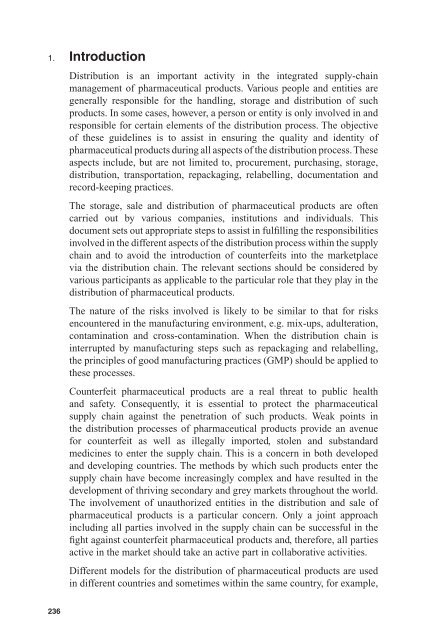Annex 5 WHO good distribution practices for pharmaceutical products
Annex 5 WHO good distribution practices for pharmaceutical products
Annex 5 WHO good distribution practices for pharmaceutical products
You also want an ePaper? Increase the reach of your titles
YUMPU automatically turns print PDFs into web optimized ePapers that Google loves.
1. IntroductionDistribution is an important activity in the integrated supply-chainmanagement of <strong>pharmaceutical</strong> <strong>products</strong>. Various people and entities aregenerally responsible <strong>for</strong> the handling, storage and <strong>distribution</strong> of such<strong>products</strong>. In some cases, however, a person or entity is only involved in andresponsible <strong>for</strong> certain elements of the <strong>distribution</strong> process. The objectiveof these guidelines is to assist in ensuring the quality and identity of<strong>pharmaceutical</strong> <strong>products</strong> during all aspects of the <strong>distribution</strong> process. Theseaspects include, but are not limited to, procurement, purchasing, storage,<strong>distribution</strong>, transportation, repackaging, relabelling, documentation andrecord-keeping <strong>practices</strong>.The storage, sale and <strong>distribution</strong> of <strong>pharmaceutical</strong> <strong>products</strong> are oftencarried out by various companies, institutions and individuals. Thisdocument sets out appropriate steps to assist in fulfilling the responsibilitiesinvolved in the different aspects of the <strong>distribution</strong> process within the supplychain and to avoid the introduction of counterfeits into the marketplacevia the <strong>distribution</strong> chain. The relevant sections should be considered byvarious participants as applicable to the particular role that they play in the<strong>distribution</strong> of <strong>pharmaceutical</strong> <strong>products</strong>.The nature of the risks involved is likely to be similar to that <strong>for</strong> risksencountered in the manufacturing environment, e.g. mix-ups, adulteration,contamination and cross-contamination. When the <strong>distribution</strong> chain isinterrupted by manufacturing steps such as repackaging and relabelling,the principles of <strong>good</strong> manufacturing <strong>practices</strong> (GMP) should be applied tothese processes.Counterfeit <strong>pharmaceutical</strong> <strong>products</strong> are a real threat to public healthand safety. Consequently, it is essential to protect the <strong>pharmaceutical</strong>supply chain against the penetration of such <strong>products</strong>. Weak points inthe <strong>distribution</strong> processes of <strong>pharmaceutical</strong> <strong>products</strong> provide an avenue<strong>for</strong> counterfeit as well as illegally imported, stolen and substandardmedicines to enter the supply chain. This is a concern in both developedand developing countries. The methods by which such <strong>products</strong> enter thesupply chain have become increasingly complex and have resulted in thedevelopment of thriving secondary and grey markets throughout the world.The involvement of unauthorized entities in the <strong>distribution</strong> and sale of<strong>pharmaceutical</strong> <strong>products</strong> is a particular concern. Only a joint approachincluding all parties involved in the supply chain can be successful in thefight against counterfeit <strong>pharmaceutical</strong> <strong>products</strong> and, there<strong>for</strong>e, all partiesactive in the market should take an active part in collaborative activities.Different models <strong>for</strong> the <strong>distribution</strong> of <strong>pharmaceutical</strong> <strong>products</strong> are usedin different countries and sometimes within the same country, <strong>for</strong> example,236
















